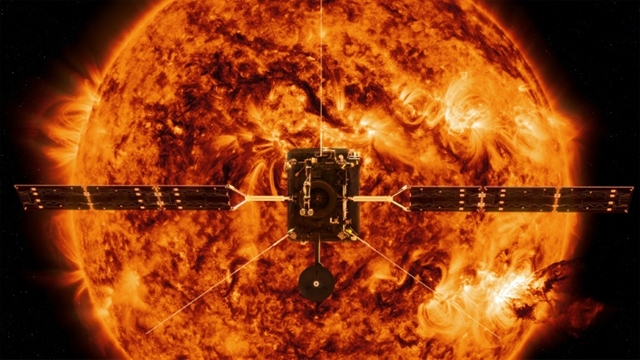 World
World


|
| This handout illustration image provided by NASA shows the Solar Orbiter, which, in collaboration with the European Space Agency, was set to be launched late February 9, 2020 on a mission to study the Sun's polar regions and magnetic environment. — Photo AFP |
MIAMI — The US-European Solar Orbiter probe launches on Sunday night from Florida on a voyage to deepen our understanding of the Sun and how it shapes the space weather that impacts technology back on Earth.
The mission, a collaboration between ESA (the European Space Agency) and NASA, is set to blast off from the Kennedy Space Center in Cape Canaveral at 11.03 pm (0403 GMT Monday) and could last up to nine years or even beyond.
Scientists say the craft is expected to provide unprecedented insights into the Sun's atmosphere, its winds and its magnetic fields, including how it shapes the heliosphere, the vast swath of space that encompasses our system.
By journeying out of the ecliptic plane -- the belt of space roughly aligned with the Sun's equator, through which the planets orbit -- it will also garner the first-ever images of our star's uncharted polar regions.
Drawing on Earth's and Venus' gravity, Solar Orbiter will slingshot itself into a bird's eye view of the Sun's poles, and will be the first probe to capture images of the difficult-to-reach region.
"It will be terra incognita," Daniel Muller, ESA project scientist for the mission in the Netherlands, was quoted as telling the NASA website. "This is really exploratory science."
The satellite is set to hit a maximum speed of 245,000 kilometers per hour (150,000 mph) before settling into orbit around the Sun.
Space weather
Ten state-of-the-art instruments on board will record myriad observations to help scientists unlock clues about what drives solar winds and flares.
These emit billions of highly charged particles that impact the Earth, producing the spectacular Northern Lights. But they can also disrupt radar systems, radio networks and even, though rarely, render satellites useless.
The largest solar storm on record hit North America in September 1859, knocking out much of the continent's telegraph network and bathing the skies in an aurora viewable as far away as the Caribbean.
"Society increasingly relies on what happens in space, and therefore we're more dependent on what the Sun is doing," said Etienne Pariat, a researcher at the CNRS observatory in Paris.
"Imagine if just half of our satellites were destroyed," added Matthieu Berthomier, a researcher at the Paris-based Plasma Physics Laboratory. "It would be a disaster for mankind."
Titanium heat shield
The probe's closest approach will come every six months, when Solar Orbiter will be nearer to the Sun than Mercury, a mere 26 million miles (42 million kilometers) away.
With a custom-designed titanium heat shield, it is designed to withstand temperatures as high as 500 Celsius (930 Fahrenheit). Its heat-resistant structure is coated in a thin, black layer of calcium phosphate, a charcoal-like powder that is similar to pigments used in prehistoric cave paintings.
The shield will protect the instruments from extreme particle radiation emitted from solar explosions.
All but one of the spacecraft's telescopes will peep out through holes in the heat shield that open and close in a carefully orchestrated dance, while other instruments will work behind the shadow of the shield.
Just like Earth, the Sun's poles are extreme regions quite different from the rest of the body. It is covered in coronal holes, cooler stretches where fast-gushing solar wind originates.
Scientists believe this region could be key to understanding what drives its magnetic activity.
Every 11 years, the Sun's poles flip: north becoming south and vice versa. Just before this event, solar activity increases, sending powerful bursts of solar material into space.
Solar Orbiter will observe the surface as it explodes and record measurements as the material goes by the spacecraft.
The only spacecraft to previously fly over the Sun's poles was another joint ESA/NASA venture, the Ulysses, launched in 1990. But it got no closer to the Sun than the Earth is.
"You can't really get much closer than Solar Orbiter is going and still look at the Sun," ESA's Muller said.
The mission will be controlled from the European Space Operations Center in Darmstadt, Germany.
After launch, the team will conduct three months of testing to ensure systems are operating properly before turning on the in situ instruments.
The remote-sensing instruments will be activated on Solar Orbiter's first approach of the Sun, in November 2021. — AFP




